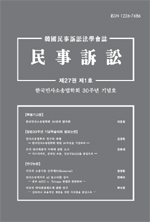The mediation procedure of the Mediation Committee of the Korea Medical Dispute Mediation and Arbitration Agency can be evaluated as having little systematic consistency with the mediation procedure of the Singapore Convention. That’s because the system has modeled after the Korea Civil Mediation Act, which is understood as the Court Mediation Act. For this reason, the Medical Dispute Mediation and Arbitration Agency does not define the concept of the mediation procedure on the mediation committee training program also, rather the program introduces Korea Supreme Court precedents. So the contents of the training program appears to similar to the case law training for judges (or those expected to be) in charge of medical dispute cases or lawyers (including law professors). This could be understood as the identity of medical dispute mediation has based on the court mediation followed by the Civil Mediation Act, and it is understood as a procedure similar to a trial in court. The Korea Medical Mediation and Arbitration Agency understand mediation as a quasi-judicial body, and the documents of mediation records has the same effect of court settlement and court judgment. However, understanding the Medical Dispute Mediation and Arbitration Agency as a quasi-court institute that conducts a judgment with the same procedure as a court decision, is the same as declaring that the Korea Medical Dispute Mediation and Arbitration Agency is another court that conducts a trial without a sitting judge established in the executive branch (even if a sitting judge is dispatched to the agency, it is not a court judgment made sitting judge because the medical mediation and arbitration agency is an institution other than a court). Some scholar says that there is no problem because it is in accordance with the Medical Dispute Mediation Act created by the Korean National Assembly, but it is questionable whether the National Assembly could create similar court by law is according to Korea constitutional law. The Korea Constitutional law provision in Article 27, Paragraph 1 says “All citizens shall have the right to a trial according to law by sitting judges established by the Constitution and law,” which does not refer to the mediation system of the Medical Dispute Mediation and Arbitration Agency in general, the Article 27, Paragraph 1 refer to the Agency mediation each process conducted by 5 mediators of medical dispute mediation and mediators’ every mediation process must meet the provisions of the Constitution in each case. This is because, as long as it is the mediation of the Medical Dispute Mediation and Arbitration Agency, it is not an abstract evaluation of the overall medical dispute mediation Agency procedure that complies with Article 27 of the Constitution regardless of how the each mediation processes are conducted, but rather in a specific evaluation of whether the progress of the each mediation cases of the Medical Dispute Mediation and Arbitration Agency satisfies the procedural standards set forth in the Constitution. This is also the reason why, in almost all countries except Japan, the evaluation of the mediation process is focuses on the evaluation of the individual mediator’s compliance with the mediation procedure, and the improvement of the mediator’s qualifications through the mediator’s education, rather than the evaluation of the institution. Therefore, the right of the people to a trial is not satisfied with the mediation of the Medical Dispute Mediation and Arbitration Agency itself, but as mentioned in Korea Constitutiona Court decision 91 Heon-ga 7, the “third-party nature and independence, fairness of procedure (節次) and prudence (愼重性)” of the person(Neutrals) conducting the procedure in each case must be secured.
Ⅰ. 싱가포르 협약 준비 상황과 의료분쟁조정제도의 관계
Ⅱ. 의료분쟁조정중재원의 조정절차와 싱가포르 협약 조정절차와의 차이 및 정합성에 대한 검토
Ⅲ. 의료분쟁조정과 민사조정 및 민사소송절차와의 절차적 구별 필요성
Ⅳ. 결어
(0)
(0)
